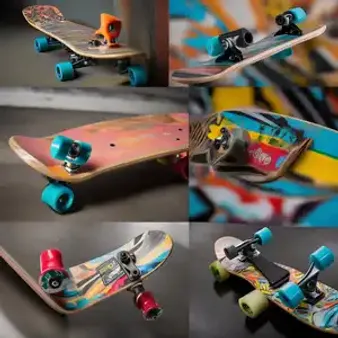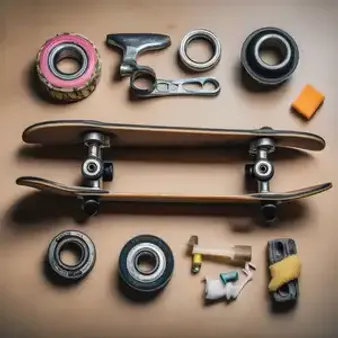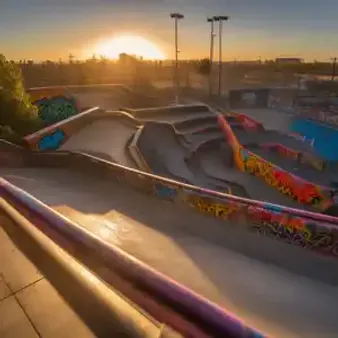Table of Contents
Ready to ride? A skateboard board is your ticket to an exciting world of tricks, cruising, and self-expression. Whether you’re a beginner finding your footing or a seasoned skater looking to upgrade, kizworld is here to break down everything you need to know about skateboard boards.
Feature | Description | Importance |
|---|---|---|
Deck Size | Width and length of the board | Impacts balance and foot placement for tricks |
Deck Shape | Concave, nose and tail shape | Influences turning, pop, and overall riding style |
Trucks | Metal components connecting wheels to the deck | Determine turning responsiveness and stability |
Wheels | Vary in size, hardness, and core material | Affect speed, grip, and riding experience on different surfaces |
Bearings | Small metal rings inside the wheels | Allow for smooth and efficient rolling |
Choosing the Right Skateboard Board
Picking the right skateboard board is like choosing the right pair of shoes – it needs to fit you and what you want to do! First things first: what kind of skating are you into? Cruising around town is different from hitting ramps at the skatepark. For cruising, a longer and wider board, like a surf skateboard, might be your jam. It's all about stability and a smooth ride. But if you're all about tricks and park sessions, a shorter, narrower board is where it's at, giving you more control for flips and grinds. Think of it like this: a big, comfy cruiser is like a chill bike ride, while a nimble trick board is like a BMX bike ready for action!
- Cruising: Longer and wider boards
- Tricks: Shorter and narrower boards
Don't forget about the board's shape! Some boards have a concave shape, kind of like a spoon, which helps you control the board with your feet. The nose and tail of the board can be shaped differently too, affecting how easy it is to pop the board for tricks. It's like the difference between a regular spoon and a soup spoon – they both scoop, but in different ways! My first board was a classic popsicle shape – perfect for learning the basics and figuring out my style. Try out different shapes at the skate shop and see what feels right for you. You'll know it when you hold it!
Choosing the Right Skateboard Board
Skateboard Board Components: A Closer Look
Dissecting the Deck
Let's break down a skateboard board, piece by piece, starting with the star of the show – the deck! This is what you stand on, and it's usually made of layers of maple wood glued and pressed together for strength and flexibility. Think of it like a sturdy, yet slightly bendy, wooden sandwich! Decks come in different sizes, just like shoes. A wider deck gives you more foot space, which is awesome for balance if you're just starting out or love to cruise. A narrower deck gives you more control for flipping the board – perfect if you're all about those sweet tricks. You can learn more about finding the right fit in our guide on choosing the right skateboard.
Now, let's talk shape. Some decks have a concave, like a gentle bowl shape underneath. This helps you steer by letting you press down on the edges with your feet. It's like how you turn a bike by leaning – except you're using your feet! The nose and tail (the curved ends of the board) also play a big role. A steeper kicktail (the upturned part of the tail) gives you more leverage for popping ollies (that cool trick where the board seems glued to your feet!). Choosing the right deck is like picking the right tool for the job – it depends on your skating style and what you want to do.
Deck Feature | Description |
|---|---|
Width | Wider for stability, narrower for tricks |
Concave | Bowl-like shape for better control and turning |
Kicktail | Upturned part of the tail for popping ollies and other tricks |
Wheels, Trucks, and Bearings: The Supporting Cast
Next up, we've got the trusty trucks – the metal parts that connect the wheels to the deck and let you steer. They have a kind of T-shape, and they're what you adjust to loosen or tighten your turning. Loose trucks mean you can turn super easily (almost like surfing!), but they can also be a bit wobbly, especially for beginners. Tight trucks give you more stability, which is great for learning or cruising, but they don't turn as sharply. It's all about finding the right balance! Check out our article on skateboarding boards and trucks for more tips on choosing the right setup.
Now, let's roll onto the wheels! Skateboard wheels come in different sizes and hardnesses. Bigger, softer wheels are like the monster truck tires of the skateboarding world – they're great for cruising over cracks and bumps, giving you a smooth ride. Smaller, harder wheels are more like race car tires – they're fast and responsive, perfect for tricks and street skating. And then there are bearings – the little metal rings inside the wheels that make them spin. Good bearings will have you rolling smoothly and effortlessly, like a whisper on the wind! Learn more about optimizing your ride with our guide on skateboarding wheels and bearings.
- Loose trucks: Easy turning, but less stable
- Tight trucks: More stability, but less turning radius
- Big, soft wheels: Smooth ride over rough surfaces
- Small, hard wheels: Fast and responsive for tricks
Skateboard Board Components: A Closer Look
Maintaining Your Skateboard Board
Taking care of your skateboard board is like taking care of your favorite pair of sneakers – it'll last longer and ride smoother if you show it some love! First off, keep it dry! Wood and water don't mix, and a soggy board can warp and lose its pop. Think of it like a sad, soggy piece of bread – not good for riding! If your board gets wet, wipe it down and let it air dry completely before you skate it again. You can learn more about caring for your board in our guide on choosing the right skateboard.
Maintaining Your Skateboard Board
Taking Your Skateboard Board Skills to the Next Level
Alright, so you've got the basics down – you can push, steer, maybe even land a few ollies. Now it's time to step up your game! Think of it like leveling up in your favorite video game. Start by mastering those fundamental tricks like kickflips and heelflips – they're the building blocks for more advanced moves. Practice makes perfect, so don't get discouraged if you don't nail it on the first try (or the tenth!). Once you've conquered the basics, it's time to get creative. Hit up the skatepark and try out different obstacles – ramps, rails, even stairs! It's all about pushing your boundaries and discovering your own unique style. You can even grab some friends and learn from each other – after all, skateboarding is more fun with a crew!
Taking Your Skateboard Board Skills to the Next Level
Final Thought
A skateboard board is more than just a piece of wood with wheels – it’s a tool for creativity, a source of fun, and a companion for adventure. By understanding the basics, choosing the right board, and practicing regularly, you’ll be well on your way to mastering the art of skateboarding and experiencing the thrill of the ride. So grab your board, hit the streets (or the skatepark!), and let the good times roll!